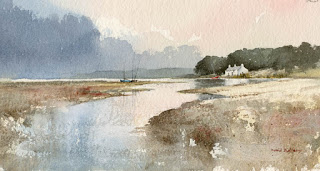It’s been some time since I last created a blog post – the problem has been that the Blogspot blogging software appears to have been crapulated by the blogging company without warning or providing any idea of how to fix it. The pictures simply appear as a string of incomprehensible characters, which of course, is not what you would want to see. Additionally I have been away from home a lot this summer, but now we’re trying to fix it.
The image I have before me is an 8-line string of characters, but I am hoping that the resulting image on your screens will be a watercolour of the River Wye in Summer. The mountain and water have been kept simple, the more distant water a horizontal sweep of cobalt blue with very little water on the brush, softening down into a light area, with some dark reflections introduced at the sides. The dark tones on the closer trees suggest the impression of distance in the composition. I have over-done the foreground flower collection a bit, but sometimes it is interesting to include strong detail in the foreground when most of the composition is quite simple. The painting will be part of a small exhibition at Erwood Station Gallery & Craft Centre, which lies a few miles south of Builth Wells in Powys. It starts on Saturday 23rd September and runs until 15th October, every day. I shall be giving a demonstration of painting the Wye in watercolour on Monday 25th September at 7pm, admission by ticket only because of limited space. Telephone 01982 560555 for the Centre. More details with the next blog which hopefully will have all the problems resolved, although at the moment I’m more inclined to believe in magic than these software geeks!




